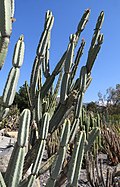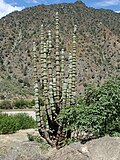Classification System: APG IV
Superregnum: Eukaryota
Regnum: Plantae
Cladus: Angiosperms
Cladus: Eudicots
Cladus: Core eudicots
Ordo: Caryophyllales
Familia: Cactaceae
Subfamilia: Cactoideae
Tribus: Echinocereeae
Genus: Armatocereus
Species: A. cartwrightianus – A. godingianus – A. laetus – A. matucanensis – A. procerus – A. rauhii – A. riomajensis
Source(s) of checklist:
Name
Armatocereus Backeb., Blätt. Kakteenf. 1938(6): 21. (1938)
Type species: Armatocereus laetus (Kunth) Backeb.
Distribution
Native distribution areas:
Continental: Southern America
Regional: Western South America
Ecuador, Peru
References: Brummitt, R.K. 2001. TDWG – World Geographical Scheme for Recording Plant Distributions, 2nd Edition
References
Primary references
Backeberg, C. 1938: Blätt. Kakteenf. 1938(6): 21.
Additional references
Korotkova, N., Aquino, D., Arias, S., Eggli, U., Franck, A., Gómez-Hinostrosa, C., Guerrero, P.C., Hernández, H.M., Kohlbecker, A., Köhler, M., Luther, K., Majure, L.C., Müller, A., Metzing, D., Nyffeler, R., Sánchez, D., Schlumpberger, B. & Berendsohn, W.G. 2021. Cactaceae at Caryophyllales. org–a dynamic online species-level taxonomic backbone for the family. Willdenowia 51(2): 251–270. DOI: 10.3372/wi.51.51208 Open access Reference page.
Links
Korotkova, N. et al. 2021. Armatocereus in Cactaceae at Caryophyllales.org. A global synthesis of species diversity in the angiosperm order Caryophyllales. Published on the internet. Accessed: 2021 Dec 08. Reference page.
Govaerts, R. et al. 2021. Armatocereus in Kew Science Plants of the World online. The Board of Trustees of the Royal Botanic Gardens, Kew. Published on the internet. Accessed: 2021 Dec 08. Reference page.
International Plant Names Index. 2021. Armatocereus. Published online. Accessed: Dec 08 2021.
Tropicos.org 2021. Armatocereus. Missouri Botanical Garden. Published on the internet. Accessed: 2021 Dec 08.
Hassler, M. 2021. Armatocereus. World Plants: Synonymic Checklists of the Vascular Plants of the World In: Roskovh, Y., Abucay, L., Orrell, T., Nicolson, D., Bailly, N., Kirk, P., Bourgoin, T., DeWalt, R.E., Decock, W., De Wever, A., Nieukerken, E. van, Zarucchi, J. & Penev, L., eds. 2021. Species 2000 & ITIS Catalogue of Life. Published on the internet. Accessed: 2021 Dec 08. Reference page.
USDA, ARS, Germplasm Resources Information Network. Armatocereus in the Germplasm Resources Information Network (GRIN), U.S. Department of Agriculture Agricultural Research Service. Accessed: 09-Oct-10.
Vernacular names
فارسی: کاکتوسهای زرهی
lietuvių: Klostenis
svenska: Väpnarkaktussläktet
Armatocereus (from Latin armatus, "armed" and cereus, "pliant/soft") is a genus of mostly tree-like cacti from South America (Ecuador and Peru). These species have a conspicuous constriction at the end of the annual growth. The flowers are mostly white, with a more or less spiny ovary. The fruits are mostly spiny.
Description
Armatocereus species are columnar cacti, bushlike or treelike, with cylindrical upright branched stems. The stems have 5–12 distinct ribs, and are made up of sections with a narrower "neck" between them, corresponding to annual growth. The large areoles bear strong spines, rarely few or none. The narrow tubular flowers appear at night, and have a spiny ovary and floral tube and white petals (red in A. rauhii). The red or green fruit is large, globular or ovoid, with strong spines that are lost on maturity. It contains large black seeds, ovoid or kidney-shaped.[1]
Taxonomy
The genus name was first mentioned in print by Curt Backeberg in 1934, and again in 1935. However, at the time, the International Code of Botanical Nomenclature required a Latin description for a genus name to be accepted, and this was not published until 1938.[2][3] Armatocereus means "armed cereus", referring to the spines.[2]
Phylogeny and classification
Classifications based on morphological characters placed Armatocereus in the subfamily Cactoideae, tribe Browningieae.[2][4] However, molecular phylogenetic studies have repeatedly shown that the tribe Browningieae is not monophyletic (like most other traditional cactus tribes).[5][6][7] A 2011 study places Armatocereus in a clade called "PHB", as it contains members of the previously defined tribes Pachycereeae, Hylocereeae and Browningieaes; other Browningieae members, including Browningia, are placed in a more distantly related BCT clade. The main clades in the resulting phylogeny are shown below.[7]
| Cactoideae |
|
Species
The taxonomy of the genus and of its species was described as "confusing" by Edward F. Anderson in 2001.[2] The Plant List (version 1.1, September 2013) accepts six species:[8]
| Image | Scientific name | Distribution |
|---|---|---|
 |
Armatocereus cartwrightianus (Britton & Rose) Backeb. | Ecuador and Peru |
 |
Armatocereus godingianus (Britton & Rose) Backeb. | Ecuador and Peru |
 |
Armatocereus laetus (Kunth) Backeb. | Peru |
 |
Armatocereus matucanensis Backeb. | Ecuador and Peru |
| Armatocereus procerus Rauh & Backeb. | Southern Peru. | |
 |
Armatocereus rauhii Backeb. | north of Peru |
Other sources, including Anderson (2001), list further species not accepted in The Plant List:[1][9]
Armatocereus arduus F.Ritter = A. rauhii
Armatocereus ghiesbreghtii (K.Schum.) F.Ritter – status unresolved in The Plant List
Armatocereus mataranus F.Ritter = A. matucanensis
Armatocereus oligogonus Rauh & Backeb. = A. matucanensis
Armatocereus riomajensis Rauh & Backeb. = A. matucanensis
Armatocereus rupicola F.Ritter = A. rauhii
Distribution and habitat
The genus is found in Ecuador and Peru, with most species occurring in Peru.[1] (Older sources include Stenocereus humilis in the genus, which occurs in Columbia.[2])
References
Ostolaza Nano, Carlos (2006), "El Género Armatocereus Backeberg", Zonas Áridas (in Spanish), 10 (1), retrieved 2017-03-24
Anderson, Edward F. (2001), The Cactus Family, Pentland, Oregon: Timber Press, ISBN 978-0-88192-498-5, pp. 112f.
"IPNI Plant Name Query Results for Armatocereus", The International Plant Names Index, retrieved 2017-03-26
Anderson (2001, pp. 101–103)
Nyffeler, Reto (2002), "Phylogenetic relationships in the cactus family (Cactaceae) based on evidence from trnK/matK and trnL-trnF sequences", American Journal of Botany, 89 (2): 312–326, doi:10.3732/ajb.89.2.312, PMID 21669740
Ritz, Christiane M; Martins, Ludwig; Mecklenburg, Rainer; Goremykin, Vadim & Hellwig, Frank H (2007), "The Molecular Phylogeny of Rebutia (Cactaceae) and Its Allies Demonstrates the Influence of Paleogeography on the Evolution of South American Mountain Cacti", American Journal of Botany, 94 (8): 1321–1332, doi:10.3732/ajb.94.8.1321, PMID 21636499
Hernández-Hernández, Tania; Hernández, Héctor M; De-Nova, J. Arturo; Puente, Raul; Eguiarte, Luis E & Magallón, Susana (2011), "Phylogenetic relationships and evolution of growth form in Cactaceae (Caryophyllales, Eudicotyledoneae)", American Journal of Botany, 98 (1): 44–61, doi:10.3732/ajb.1000129, PMID 21613084
"Search results for Armatocereus", The Plant List, retrieved 2015-09-08
Arakaki, M.; Ostolaza, C.; Cáceres, F. & Roque, J. (2006), "Cactaceae endémicas del Perú", Revista Peruana de Biología (in Spanish), 13 (2): 193–291, retrieved 2013-03-25
Retrieved from "http://en.wikipedia.org/"
All text is available under the terms of the GNU Free Documentation License

